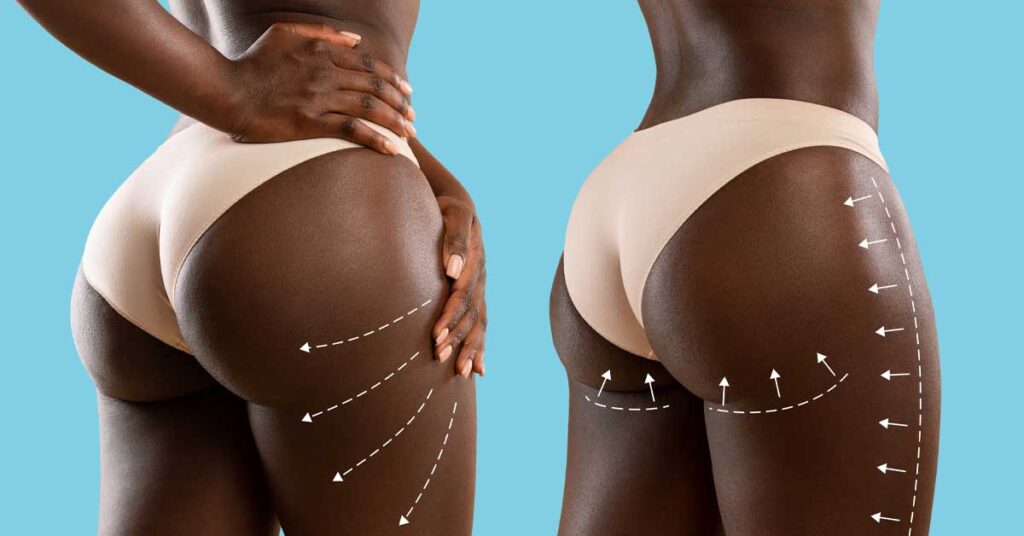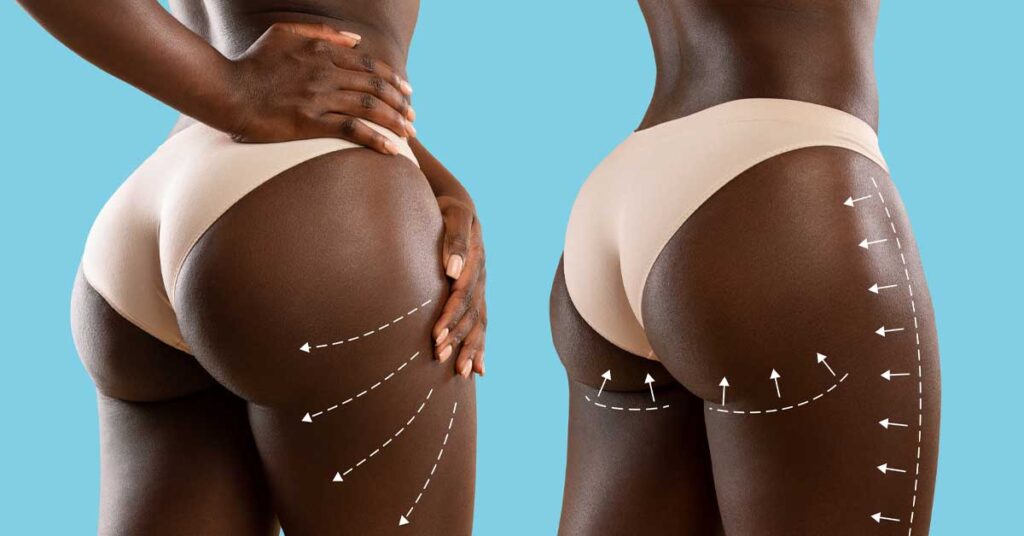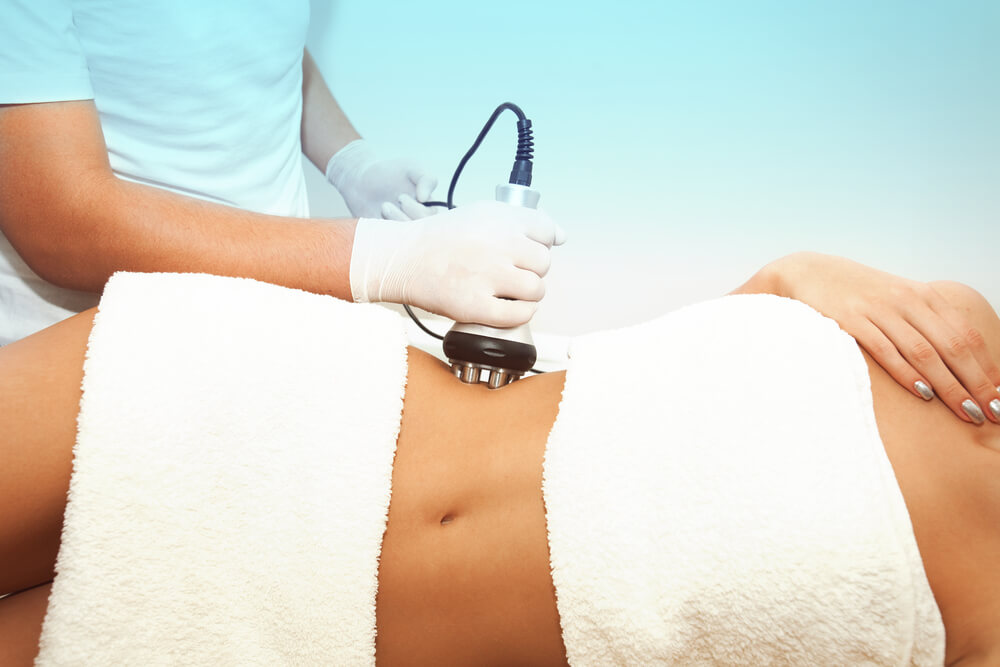Key Takeaways
-
A Brazilian Butt Lift (BBL) procedure is a body contouring enhancement that uses fat transfer to the buttocks. Cosmetic Benefits
This procedure offers a natural alternative to implants and other enhancement methods. The procedure requires liposuctioning fat from other areas of the body to inject it into the buttocks.
-
The path to a safe procedure begins with working with an ASPS member—a board-certified plastic surgeon. Asking these questions and verifying their credentials, experience, and complication rates can help you avoid potential risks during the procedure.
-
Thorough pre-operative evaluations are necessary in order to figure out whether or not you are a good candidate. Be open about your medical history, lifestyle habits, and aesthetic goals with your surgeon.
-
Employing safe fat transfer techniques is crucial for preventing the most serious complications. Performing these procedures in accredited surgical facilities minimizes the risks of complications including fat embolism or infection.
-
Follow post-operative care guidelines, wear compression garments, and avoid direct pressure on the buttocks to facilitate healing. Never miss a follow-up appointment. It is imperative that your new body heals properly.
-
Inquire extensively at your consultation. These topics should cover your surgeon’s qualifications, their safety protocols, risks, and recovery plan to make sure you feel informed and confident.
It is important for anyone considering a Brazilian Butt Lift (BBL) to understand what makes this a safe procedure. Safety begins with understanding what questions to ask your surgeon. Main things to cover are what their qualifications are, how much experience they have performing BBL surgeries, and what techniques they employ to ensure minimal risks.
Questions about the facility’s accreditation and the process for aftercare can further clarify the safety of a BBL procedure. With a knowledgeable dialogue as your guide, you’ll leave feeling confident in the decisions you’re making for your health. By getting answers to these questions from the beginning, you can ensure the foundation for a safer, successful outcome is laid.
It all comes down to the expertise of your surgeon. All of their thoughtful, intentional measures to keep you safe play a big role.
Understanding a Brazilian Butt Lift
What is a Brazilian Butt Lift
A Brazilian Butt Lift, or BBL, is currently the fastest-growing cosmetic surgery procedure. This butt augmentation surgery improves the size and shape of the buttocks through a fat transfer technique that utilizes excess fat from other areas of the body. The process begins with liposuction, which effectively harvests fat from regions such as the abdomen, waist, or thighs.
After harvesting, the fat is purified to eliminate impurities, ensuring that only healthy fat cells are used. Finally, the experienced Brazilian butt lift surgeon injects the purified fat into the buttocks in layers, sculpting a rounder and fuller appearance.
One of the most significant benefits of a Brazilian butt lift is that it uses the patient’s own fat, greatly reducing the chance of rejection and complications typically associated with butt implants. Many patients seek this procedure to enhance their body proportions, especially if they find their buttocks to be flat or saggy.
By removing fat from the abdomen and flanks during liposuction, patients can achieve a more hourglass figure. Most individuals feel more confident and satisfied with their new look once they’ve fully recovered from the butt lift surgery.
Why safety is critical for a BBL
No matter which procedure you’re considering, choosing a highly qualified and experienced surgeon is key to a safe BBL. As the procedure exploded in popularity, that popularity has led to the development of unsafe practices.
For instance, some practitioners inject fat in the muscle, incurring severe complications such as fat embolism. A complete pre-operative evaluation will determine if there are health risks present, and allow for the surgery to be customized to each patient’s needs.
When you choose to follow established techniques and safety guidelines, risks are reduced and results are enhanced.
Common risks and complications
Though their risks are well known, fat embolism remains one of the most serious complications of BBLs. Other possible risks are infection, scarring, and asymmetrical results.
These complications are typically the result of malpractice and negligence. For example, slumping directly onto the buttocks too early after surgery can compromise fat retention.
Individual health factors such as smoking or preexisting conditions may raise the risk of complications. Patient education and proper post-operative care are integral to mitigating these risks.
Factors That Ensure a Safe BBL
Importance of Board-Certified Surgeons
One of the best markers for patient safety is board certification, which is a great indication of a surgeon’s qualifications and commitment to safety. Surgeons who are certified by the American Board of Plastic Surgery (ABPS) have gone through the most strenuous training.
Moreover, as members of the American Society of Plastic Surgeons (ASPS), they are held to rigorous medical standards. Keep in mind that your surgeon should be registered with GMC (General Medical Council), or equivalent body in the U.S. Your health and safety are too important to leave to chance.
Always inquire about how many Brazilian Butt Lifts (BBLs) they’ve done. Understanding how many procedures they’ve completed will give you further insight into their skillset.
Proper Patient Evaluation and Suitability
A thorough evaluation is the foundation to a safe and successful BBL. Your surgeon should consider your complete medical history, look for any underlying conditions and perform a physical exam.
They’ll evaluate your body type and the availability of fat, as only about 60% of the transferred fat survives long-term. Ensure alignment and realistic outcomes. Open communication is key—talk about your goals and expectations upfront to set realistic outcomes.
Safe Fat Transfer Techniques
Techniques like these are vital to reducing risks. Using special techniques with these specialized tools, surgeons delicately inject fat into specific, strategic areas and avoid high-pressure techniques that can cause severe complications.
Safety depends on precision and expertise in placement fat, which boosts safety and outcome.
Operating in Accredited Surgical Facilities
Accredited centers ensure high safety standards, with the proper protocols and procedures in place, and emergency care readily available should the need arise.
These exclusive and specialized facilities are the only place that can manage severe complications in a controlled, managed, safe facility.
Post-Operative Care and Recovery Planning
-
Avoid sitting directly on buttocks for 2 weeks.
-
Use a BBL cushion for comfort.
-
Follow medication and care instructions closely.
Questions to Ask Your Surgeon
1. Are you board-certified in plastic surgery
Begin by verifying that your surgeon is board certified in plastic surgery. This means they’re held to rigorous industry standards and have undergone years of specialized training.
Surgeon board certification indicates a pledge to patient safety, ethical practice, and a continuing course of education. Ask what kind of training they’ve received specifically for Brazilian Butt Lift (BBL) surgeries.
This type of specialized knowledge is crucial for providing the best, safest, and most satisfying results.

2. How many BBL procedures have you performed
Experience is key. Inquire about the number of BBL procedures your surgeon has performed, and how many were successful.
As a general rule, the higher the number, the more honed the surgeon’s techniques are, and the lower the complication rate. Ask to see before-and-afters or patient testimonials to get an idea of what to expect based on results from other patients.
It’s a clear indicator of their confidence, ability and track record in achieving the outcomes you wish to see.
3. What is your complication rate for BBLs
Knowing the surgeon’s complication rate helps you understand their safety history. Look at their rates compared to industry averages and inquire about their plans for dealing with any complications that may arise, such as fat embolism.
Understanding their approach to a surprise complication will help you feel confident in them.
4. How do you ensure fat is injected safely
Fat injection and patient safety are our top priorities. Inquire about their approaches, including ultrasound guidance, to make sure placement is as accurate as possible.
Following proper protocols minimizes risks and maximizes fat viability (only about 60% of the fat we transfer usually stays after surgery).
5. What type of anesthesia will be used
Ask if your procedure will require general anesthesia or if it will be done with local anesthesia and sedation. Each has advantages and disadvantages, so talk about what’s safest for you.
Make sure your anesthesiologist is top-notch.
6. What are the risks and how are they managed
Avoiding what you don’t know is key. Inquire about potential complications, such as swelling or changes in sensation, and how they would be handled.
The surgeon must customize an action plan for managing those risks based on your overall health.
7. What post-operative care do you provide
Having thorough post-operative care is very important in getting patients through recovery. Inquire about follow-up visits, medications, and places you can go with questions or concerns.
Your surgeon will likely give you specific care instructions, so you’ve got everything you need to heal as quickly as possible.
8. How can I prepare for the procedure
Stick to dietary and lifestyle guidelines, plan ahead for transportation to and from your procedure, prepare a recovery area at home.
Asking these questions in advance makes for a smoother, worry-free visit.
9. Are there alternatives to a BBL
Go over non-surgical options, such as fillers, or surgical options like butt lift surgery and butt implants. Consider the pros and cons accordingly to create a tailored approach for your goals.
Preparing for Your BBL Consultation
Being well-prepared is the best way to ensure that you are making the most out of your BBL consultation. Walking into your consultation with all of this information makes you feel confident.
Second, it sets the stage for a highly productive conversation with your surgeon. Come prepared to address everything you’re worried about and receive straightforward responses. This step is necessary for advocating and choosing wisely.
Have an open heart and an open mind. Being prepared to take in new information will assist you in fully understanding the procedure and determining if it’s the right fit for you and your objectives.
Research Potential Surgeons Thoroughly
The first step in the butt lift surgery journey is finding a board-certified surgeon you can trust. Here are some tips to guide your search for an experienced plastic surgeon.
-
Look online for patient reviews and ratings to see what kind of experience other people have had.
-
Check the surgeon’s credentials by the boards such as the American Board of Plastic Surgery.
-
Request to see before-and-after photos of previous BBL cases and use this time to judge their aesthetic eye.
-
Check that the surgeon is GMC registered and has experience completing 100+ BBL procedures. This experience is usually a result of honed skills and repeatable outcomes.
-
Remember to inquire how many BBL procedures they’ve performed and what they do to ensure your safety.
Gather Your Medical History and Lifestyle Details
Before the consultation, prepare your complete medical history — including any prior surgeries, medical conditions, and allergies.
Come prepared to discuss your lifestyle habits, including diet, exercise, and smoking. These provide the surgeon with a more in-depth look at your overall health and will establish your eligibility for a BBL.
For example, being a non-smoker is a very important condition for a safe recovery, and being in great overall physical shape can even enhance your results.
List Your Goals and Expectations Clearly
Providing a clear picture of what you want to achieve and your expectations from the procedure is crucial.
Consider which areas you would like to improve and for what reasons. The more honest you are, the more your surgeon can focus the procedure around your goals and needs.
Educate yourself and set realistic expectations. Note that it can take 3-6 months for the swelling to subside and for the final results to be evident.
If you have any questions about what is possible or what to expect, don’t hesitate to ask your surgeon for help.
Prepare Additional Questions for Clarity
During your research phase, make note of any further questions. These might be questions regarding the procedure, recovery time, or cost.
For example, request a comprehensive fee breakdown, including the cost of the surgeon, anesthesia, and facility fees.
Get post-surgery care details, such as how long you should expect to be resting and what recovery procedures are most important.
Being totally informed makes you sure of yourself before taking the next step.
Recovery and Aftercare Essentials
Follow all post-surgery instructions strictly
After a Brazilian butt lift (BBL), adhering to your surgeon’s post-operative instructions is extremely important. It’s one of the most important steps you can take to ensure a successful recovery. These instructions are meant to guide you through your healing and help you achieve the best possible results.
For instance, your surgeon should be able to walk you through how to clean incisions, what medications to take, what to do about swelling or bruising, etc. Bruising and swelling are normal within the first few days, but if you take these steps, they will be less severe. If you have any questions at all, don’t be afraid to ask your surgical team—they’re there to make this process easy and straightforward.
Wear compression garments as advised
Compression garments are extremely important to the recovery process. They assist in reducing swelling, increasing blood flow, and contouring the treated area. Surgeons usually recommend wearing these garments for a minimum of 4-6 weeks after surgery, based on individual recovery rate.
To prevent chafing, avoid a loose fit, since a snug fit provides the necessary support. Sticking to the suggested timeline is extremely important, as it has a direct impact on the quality of your results.
Avoid sitting or lying on the buttocks initially
Protecting the newly transferred fat is very, very important. Surgeons usually advise against putting direct pressure on the buttocks for the first two weeks post-surgery. Instead, sleep on your side or stomach, and if sitting cannot be avoided, use a BBL specific recovery cushion.
These cushions are engineered to redistribute weight away from the treated area, preserving the integrity of the fat cells.
Monitor for signs of complications
Recovery can bring its own set of challenges, so being aware of any changes is important. If you experience excessive swelling, severe pain, or unusual redness, these could be early signs of complications. While some discomfort is normal, particularly in the first few days, don’t ignore symptoms that seem out of the ordinary.
Call your surgeon right away if anything doesn’t feel right so you can treat problems early before they escalate.
Attend all follow-up appointments
Follow-up appointments are just as critical as the butt lift surgery itself. Throughout these visits, your experienced plastic surgeon will monitor your progress, answer questions, and assist you with any recovery-related issues. These check-ins provide an opportunity to address discomfort or seek tailored advice, ensuring your healing from the brazilian butt lift procedure stays on track.
Conclusion
A safe Brazilian Butt Lift begins with knowledge, informed decisions and asking the right questions. Doing your due diligence by researching your surgeon’s credentials, making sure they use accredited facilities and being open about your health will set you up for success. Being proactive and following post-op instructions can greatly reduce your risks and lead to the best results.
Remember, your safety and well-being should come above all else. Approaching the consultation process with care and transparency will establish trust and help create an environment primed for success. Some simple planning will have you well on your way to feeling confident and prepared.
If you’re thinking about getting a BBL, avoid cutting corners. Keep these tips in mind to remain proactive and help yourself make educated decisions at every stage. Your health is too important to cut corners.
Frequently Asked Questions
What is a Brazilian Butt Lift (BBL)?
A Brazilian Butt Lift, or BBL, is a highly sought-after cosmetic surgery procedure that enhances buttocks improvement by transferring fat from other areas of the body. This fat grafting technique creates a plumper butt, achieving beautiful, natural-looking results without the need for butt implants.
What makes a BBL safe?
Board-certified cosmetic surgeons who utilize safe, precise fat injection techniques during the Brazilian butt lift procedure and thoroughly screen patients contribute to safer butt lift surgery outcomes, minimizing risks like fat embolism.
How do I know if my surgeon is qualified?
Look for board certification in plastic surgery, experience with Brazilian butt lift surgery, and before-and-after pictures. Inquire about their success rates and patient safety protocols.
What questions should I ask during my consultation?
Inquire about the qualifications of experienced plastic surgeons, understand the risks associated with the brazilian butt lift procedure, and discuss fat transfer methods to ensure a successful butt augmentation surgery and a smooth recovery.
How should I prepare for a BBL?
To ensure the best possible outcome from your brazilian butt lift surgery, avoid smoking, drink plenty of fluids, and follow your surgeon’s pre-operative instructions diligently while maintaining a healthy weight.
How long does BBL recovery take?
In general, after undergoing butt augmentation surgery, you can expect recovery to last 6–8 weeks. In addition to these tips, try not to sit flush against your buttocks for the first 2 weeks and adhere to postoperative care directives to promote healing from within.
Are there risks with a BBL?
Of course, there are risks associated with butt lift surgery, such as infection, fat embolism, or asymmetry; however, choosing an experienced plastic surgeon and strictly adhering to postoperative care instructions can significantly reduce these dangers.





















